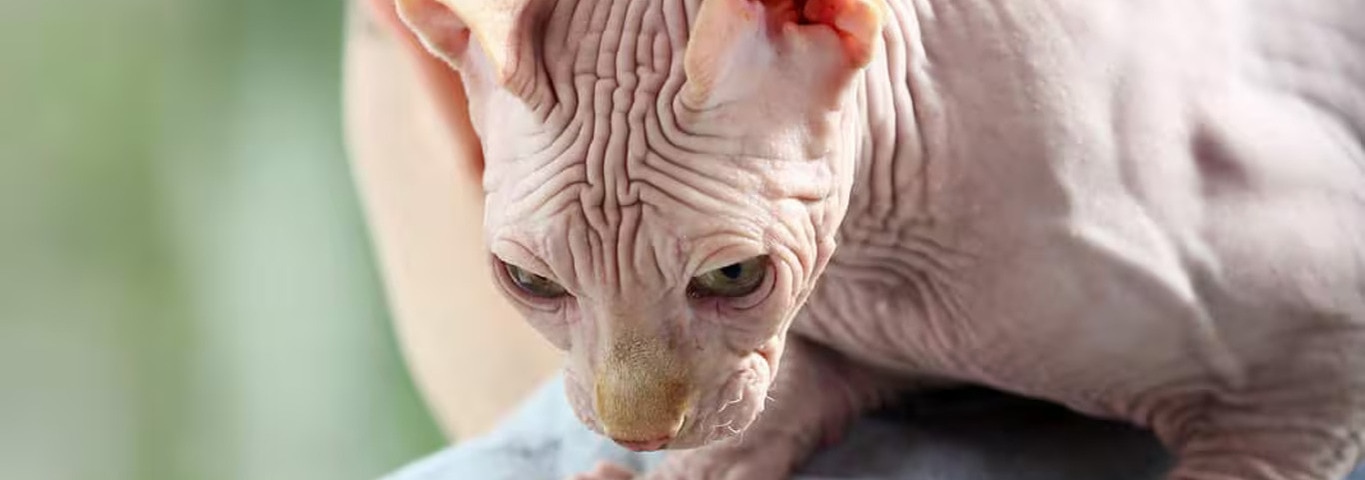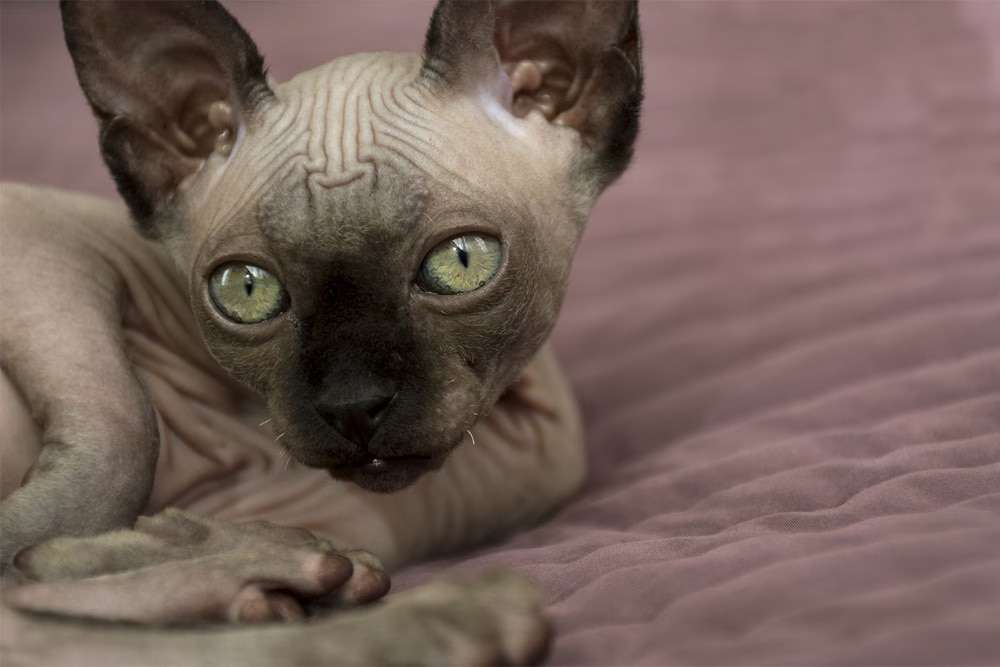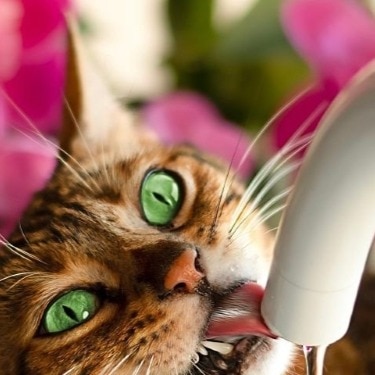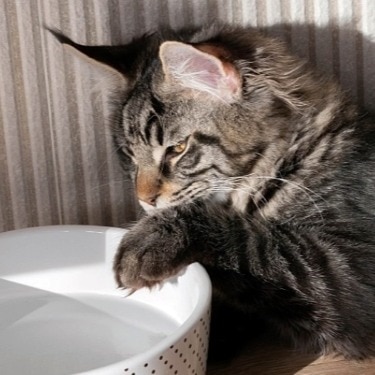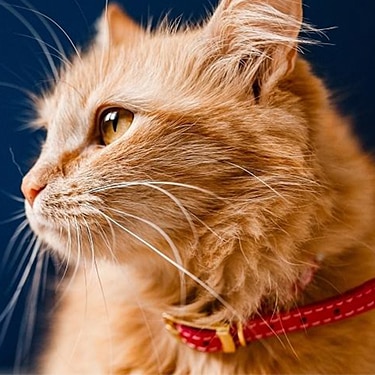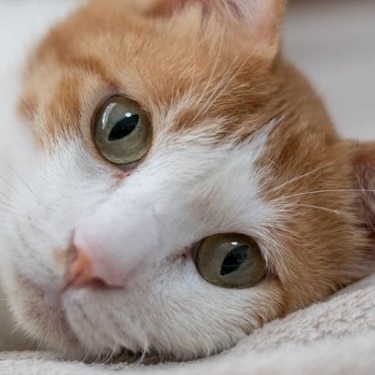The breed is medium sized but nicely muscled.
Her head is triangular with wide-set eyes and prominent cheekbones that call back to the cats of ancient Egypt, a resemblance that inspired the naming of this breed. Apart from being hairless, the sphynx's most notable feature is her large, triangle-shaped ears that resemble those of a bat.
Although the sphynx appears to be completely bald at first glance, closer inspection will often reveal a very fine, short coat of fuzz that gives the skin the feel of fine suede. It's the hairlessness that primarily marks a sphynx, with color and pattern lying in the pigmentation patterns of the skin. Color and markings can vary widely and can come in almost any color or pattern, including solid, tabby or tortoiseshell.
The sphynx cat is an energetic, acrobatic performer who loves to show off for attention. She has an unexpected sense of humor that is often at odds with her dour expression.
Friendly and loving, this is a loyal breed who will follow you around the house and try to involve herself in whatever you're doing, grabbing any opportunity to perch on your shoulder or curl up in your lap. As curious and intelligent as she is energetic, these traits can make her a bit of a handful. For her own safety, the sphynx does best as an exclusively indoor cat, and generally gets along well with children other pets.
The sphynx cat is a strong and hardy breed with few health problems. Although the breed doesn't have any genetic disease predispositions, a few health conditions have been known to affect sphynx cats, including hypertrophic cardiomyopathy (HCM), which is a disease that causes thickening of the heart muscle and can be detected with an echocardiogram, and hereditary myopathy, a condition affecting muscle function, according to Vetstreet. Sphynx cats are sometimes also prone to skin conditions such as urticaria pigmentosa, which causes crusty sores to form on the body. This breed is also prone to periodontal disease and should be provided with regular teeth brushing and dental checkups.
When adopting a sphynx cat, avoid breeders who refuse to offer a health guarantee on kittens or who make claims that their line is guaranteed HCM-free. Although this condition isn't hereditary, it's a fairly common form of heart disease in cats and no breeder can guarantee with absolute certainty that a cat won't develop HCM.
This is an active breed who enjoys jumping, playing and climbing, as well as normal cat scratching. Scratching surfaces should be provided, along with places to climb and perch.
Despite her hairlessness, the sphynx is not considered hypoallergenic because her skin still produces normal amounts of allergy-causing dander. Sphynx cats tend to have oily skin and need to be bathed regularly to avoid becoming greasy. Special care should also be taken to protect these cats from sunburn and skin damage, as well as from cold temperatures, although the sphynx tends to be an expert at finding snug places to curl up and get warm. Nevertheless, sweaters and coats tailored to the sphynx cat are commercially available. The ears should also be checked weekly for wax buildup and gently wiped with a cotton ball dipped in a gentle ear-cleaning solution as necessary.
Originally named the Canadian hairless, the sphynx got its start in Toronto, Canada in 1966 when a litter of domestic shorthair kittens included a hairless kitten as the result of a naturally occurring genetic mutation. Although other hairless kittens had been born prior to this, the sphynx as we know it today is the result of selectively breeding these hairless cats to normal-coated cats and then breeding their offspring back again to other hairless cats, a process that has not only produced the desired breed characteristics but also served to widen the gene pool to produce a genetically hardy breed of cat, according to Cattime. But it wasn't until 2002 that the Cat Fanciers' Association accepted the sphynx for competition in the championship class, and other cat associations quickly followed suit.
If the sphynx looks familiar to you, you might be thinking of Mr. Bigglesworth, the cat belonging to Dr. Evil in the Austin Powers movies, played by a sphynx by the name of Ted NudeGent. And on the TV show Friends, the character Rachel, played by Jennifer Aniston, once adopted a sphynx.
While the sphynx's unusual looks are attention-grabbing and might even be off-putting to some people, what these cats lack in fur is more than made up for in personality. Although sphynx owners are often initially attracted to the shock value of having a hairless cat, not to mention the lack of shedding to deal with, most will tell you that they fell in love with their sphynx, who proved to be a delightful pet. If you're looking for a fun and affectionate companion, you need look no further than the sphynx.
Adopt a pet. Change a life.
Are you prepared to adopt a pet? Use these tools to make sure you are ready for the commitment.
Adopt a pet. Change a life.
Are you prepared to adopt a pet? Use these tools to make sure you are ready for the commitment.












